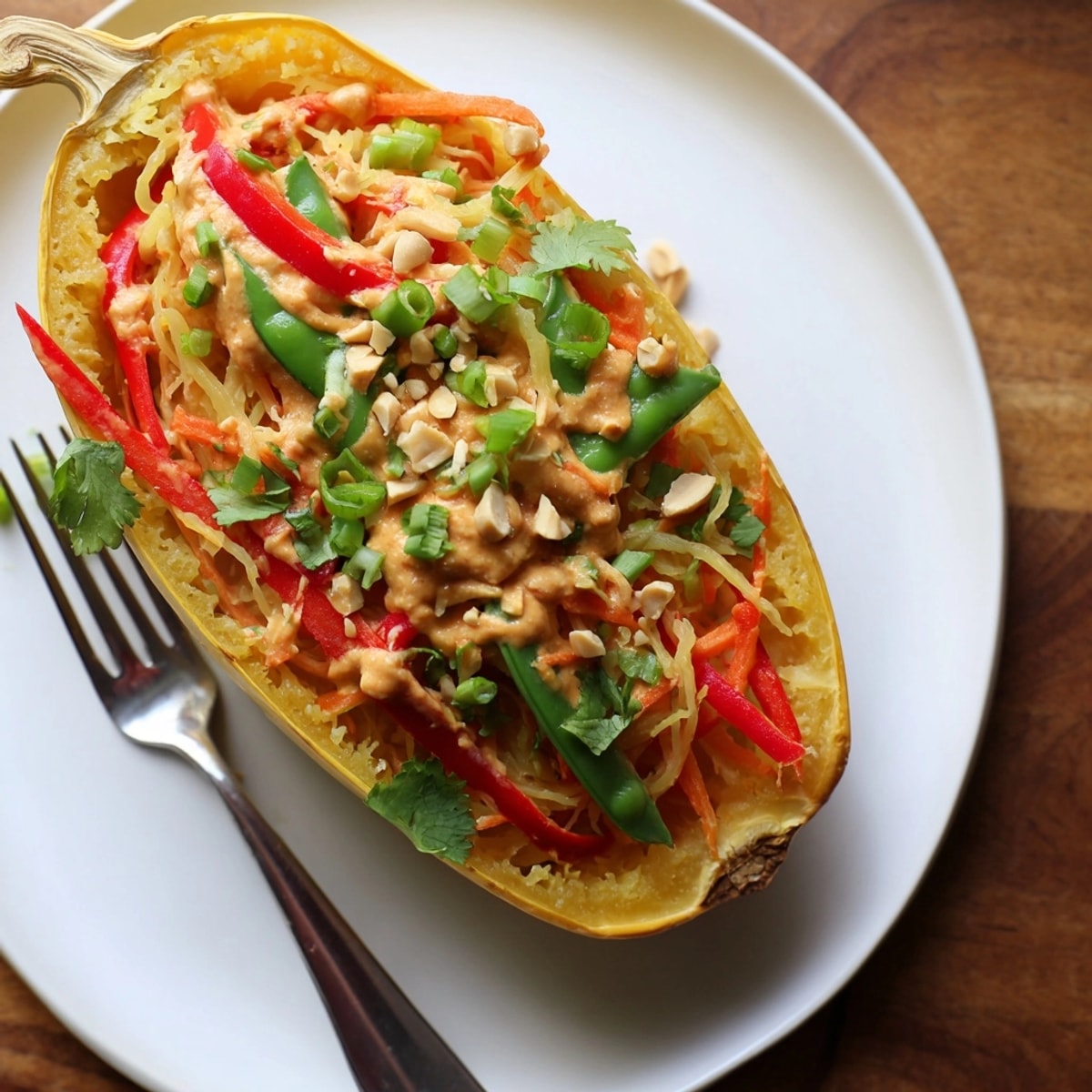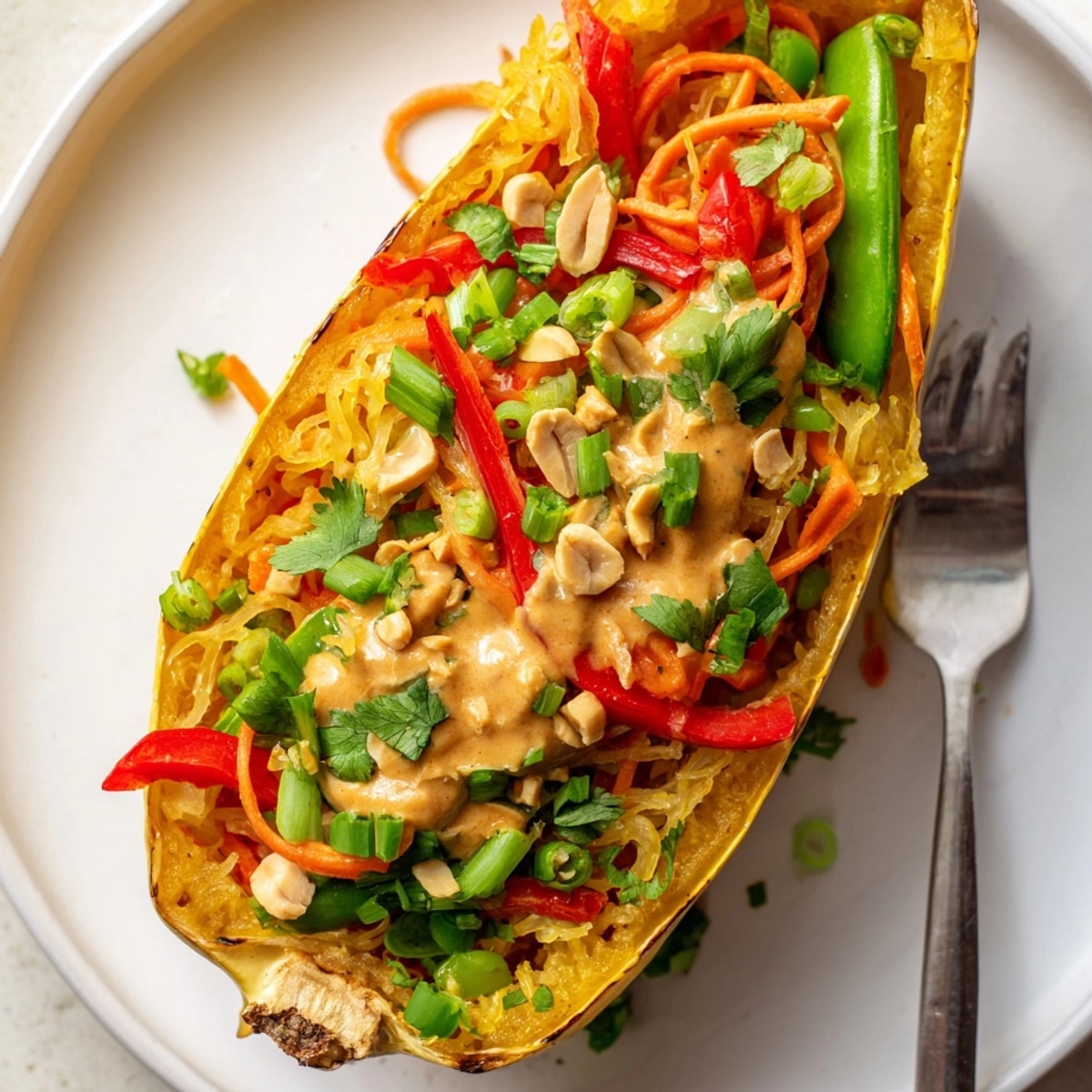 Save
Save Thai peanut spaghetti squash boats are one of those meals that always feel both comforting and adventurous. Each squash half becomes a hearty vessel, overflowing with fresh vegetables and smothered in a silky peanut sauce that brings big flavor without any of the heaviness you might expect from a classic noodle dish.
The first time I served this at a family dinner, I could hardly get the boats to the table before half were claimed. The combination of sweet squash, crunchy veggies, and zippy sauce won everyone over.
Ingredients
- Spaghetti squash: Choose two medium spaghetti squash that feel heavy for their size. When roasted, the strands shred beautifully and provide a savory, noodle-like base
- Olive oil: Brush the squash with a light layer to help it roast up tender with golden edges. Extra-virgin is best for flavor
- Salt and black pepper: These bring out the natural sweetness of the squash and balance the richness of the sauce
- Red bell pepper: Pick one with glossy skin for sweetness and crunch. This color also adds visual pop
- Shredded carrots: Buy pre-shredded for convenience or shred your own for extra crisp bite and color
- Snap peas: Look for fresh, firm pods that snap cleanly when bent. They give a juicy crunch to the filling
- Green onions: Both the white and green parts add sweet sharpness and color
- Fresh cilantro: Chop this just before serving for a burst of fresh flavor. If you are not a cilantro fan, flat-leaf parsley works too
- Roasted peanuts: Choose unsalted if possible and chop just enough to leave some texture for topping
- Peanut butter: Creamy style is essential for a luscious sauce. Natural or classic both work but give it a good stir if oil has separated
- Soy sauce or tamari: Go for low sodium options where possible to control saltiness. Tamari makes it fully gluten free
- Rice vinegar: Grab an unseasoned vinegar if you can easily find it. It brightens up the sauce
- Lime juice: Fresh-squeezed adds zing and really lifts the flavors
- Honey or maple syrup: Either one brings a touch of sweetness and helps the sauce blend smoothly
- Toasted sesame oil: A little goes a long way and gives deep nutty aroma
- Sriracha or chili garlic sauce: Start with a small amount and add more to dial up the heat as you wish
- Warm water: Add gradually to reach the ideal creamy-drizzly consistency for the sauce
Instructions
- Preheat and Prep the Oven:
- Set your oven to 400 degrees Fahrenheit or 200 degrees Celsius and line a baking sheet with parchment. This prevents sticking and helps with cleanup
- Prepare the Squash:
- Using a sturdy chef's knife, carefully slice each spaghetti squash lengthwise. Scoop out all seeds with a spoon but try not to dig into the flesh beneath. Pat each half dry if needed and brush the cut sides evenly with olive oil. Sprinkle with salt and pepper
- Roast the Squash:
- Place the halves cut side down on your prepared baking sheet. Let them roast in the center of the oven for thirty five to forty minutes. You want the flesh fork tender so strands separate with no effort. Larger squash may need a little longer
- Mix the Peanut Sauce:
- While the squash is baking, grab a medium bowl and combine peanut butter, soy sauce or tamari, rice vinegar, lime juice, honey or maple syrup, toasted sesame oil, and sriracha. Whisk gently to blend, then begin adding warm water a tablespoon at a time until the sauce is creamy and just pourable. Taste and adjust for sweetness and spice
- Chop and Combine Vegetables:
- In a large mixing bowl, bring together the thinly sliced red bell pepper, shredded carrots, halved snap peas, and half the green onions. This makes a bright and crunchy filling
- Shred Squash and Fill:
- Once the roasted squash has cooled enough to handle, gently use a fork to tease out the flesh into spaghetti like strands. Be careful to leave a border around the edge so the shells remain intact and sturdy
- Mix and Dress:
- Add the squash strands to your vegetable mix. Pour over most of the peanut sauce and toss gently so everything gets well coated but not mushy
- Stuff and Drizzle:
- Divide the mixture between the empty squash shells. Spoon it back in, pressing down lightly to fill each one generously. Drizzle the rest of the peanut sauce over the tops so it seeps into every bite
- Garnish and Serve:
- Finish with a handful of chopped roasted peanuts, remaining green onions, and a scatter of vibrant cilantro. Bring the boats to the table while warm and let everyone dig in
 Save
Save My favorite part about this dish is the sauce. Sometimes I double it and keep extra for dipping raw veggies or drizzling over grains. One afternoon I had my nephew sprinkle the peanuts and he made a huge happy mess (in our family, recipes are meant for memories like that).
Storage Tips
Let leftovers cool to room temperature before refrigerating. Store the filled squash boats in an airtight container or wrap them tightly with foil and keep in the fridge for up to four days. Reheat gently in the oven or microwave until just warmed through to keep the veggies crisp but not soggy.
Ingredient Substitutions
Feel free to swap in whatever fresh vegetables you have on hand. Broccoli slaw, shredded cabbage, or thinly sliced zucchini all work beautifully. For a soy free version, use coconut aminos in place of tamari. Sunflower seed butter can stand in for peanut butter if you are nut free.
Serving Suggestions
These squash boats make a tasty main dish on their own but pair wonderfully with steamed jasmine rice or a side of edamame. For extra crunch, serve with a quick cucumber salad drizzled in rice vinegar.
Cultural Notes
This recipe is a playful spin on classic Thai inspired noodle dishes, using spaghetti squash as a naturally gluten free and lower carb base. Peanut sauces are a staple in Southeast Asian cooking, valued for their rich flavor and creamy body. Here, those flavors join crisp veggies for a light but deeply satisfying meal.
 Save
Save If you give these a try, do not be surprised if they become a repeat favorite. Thai peanut spaghetti squash boats are a satisfying way to bring color and excitement to your dinner table or lunchbox and might just become a new go to for meatless meals.
Recipe FAQ
- → How do I make squash strands easily?
After roasting, use a fork to gently pull the flesh apart into spaghetti-like strands; cool slightly for easier handling.
- → Can I make this gluten-free?
Yes, use tamari in place of regular soy sauce to keep the dish gluten-free. Double-check all ingredient labels for hidden gluten.
- → What vegetables work best for the filling?
Red bell pepper, snap peas, shredded carrots, and green onions provide crunch and color, but feel free to substitute favorites.
- → Can I adjust the spice level?
Absolutely! Increase or decrease sriracha or chili garlic sauce to suit your heat preference. Taste the sauce and adjust as needed.
- → What protein options can I add?
Sautéed tofu or grilled chicken work well for extra protein. Mix pieces in with veggies or add on top before serving.
- → Is the sauce vegan?
Swap honey for maple syrup to make the peanut sauce vegan-friendly without changing flavor or texture.